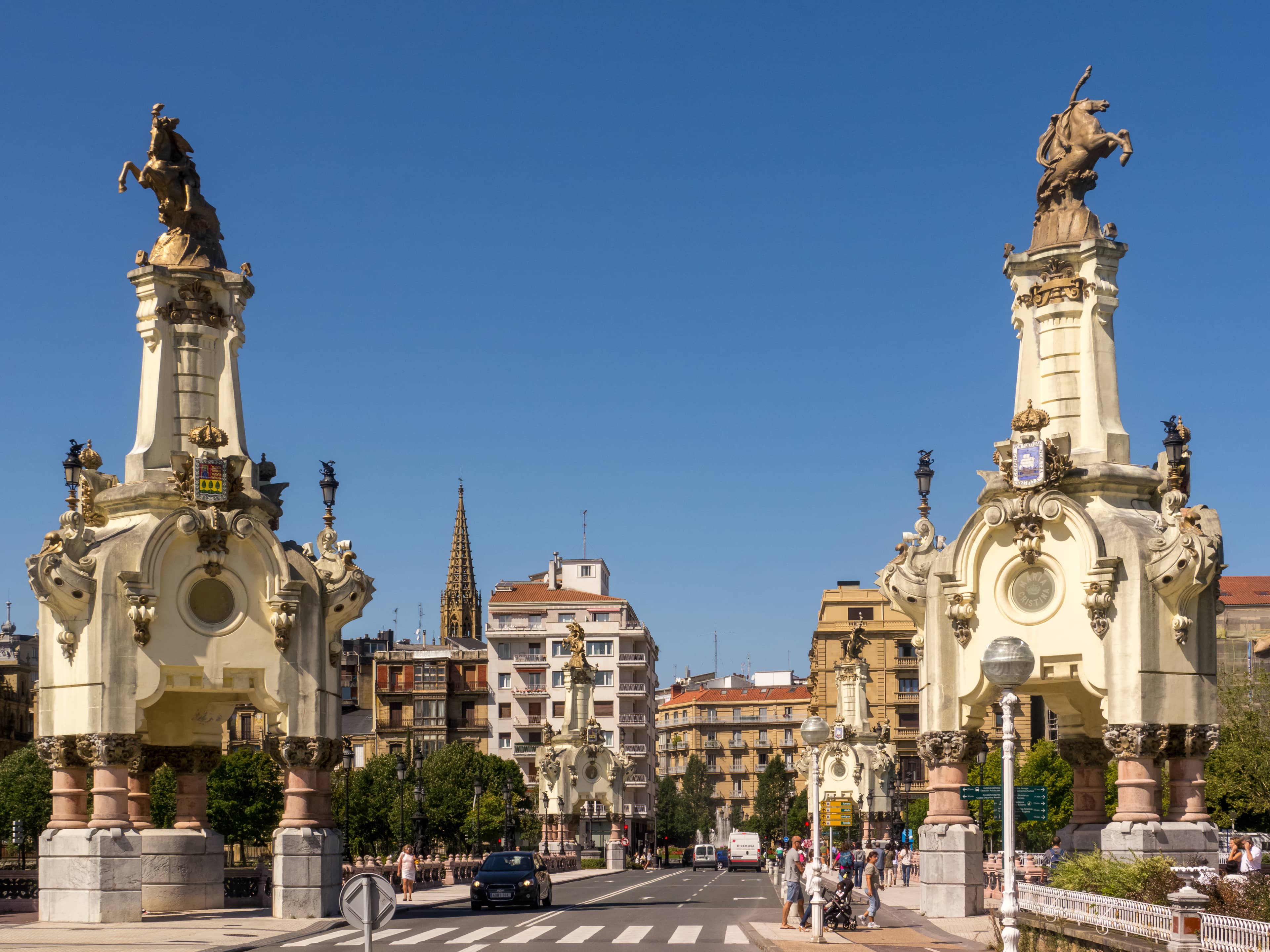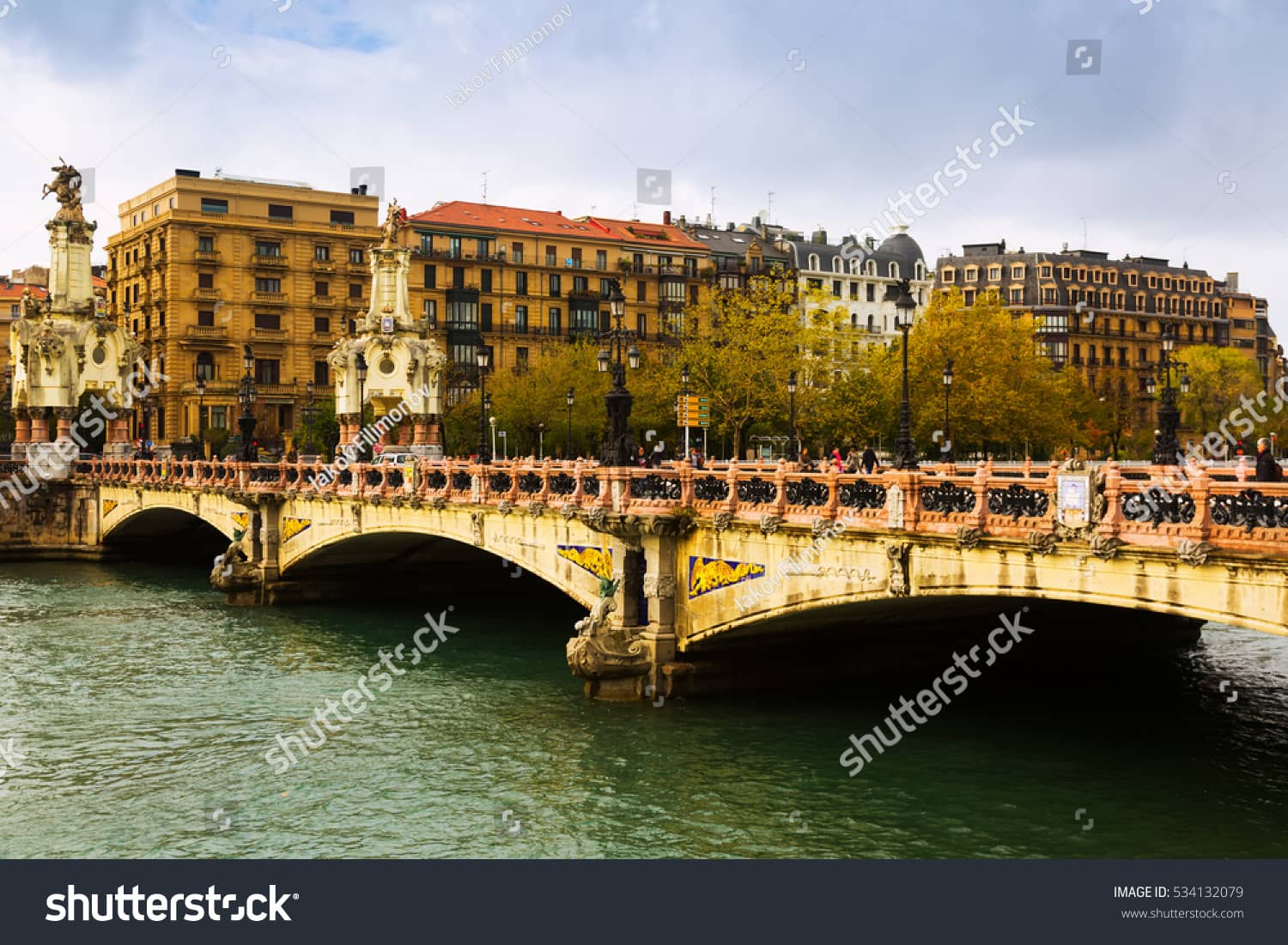Maria Cristina Bridge
An elegant Belle Époque bridge in San Sebastián, famed for its ornate obelisks and royal namesake.

Highlights
Must-see attractions

Social
From TikTok & Reddit
Best Time
Fewer crowds, soft light
Maria Cristina Bridge
Best Time
Fewer crowds, soft light

Highlights
Must-see attractions
An elegant Belle Époque bridge in San Sebastián, famed for its ornate obelisks and royal namesake.
"A beautiful bridge with ornate towers, a busy road but good pedestrian access across the river."
📸 Capture the Obelisks
The four ornate obelisks are a key feature; get shots from different angles to showcase their grandeur.
🚶♀️ Stroll Along the River
Enjoy a leisurely walk on the pedestrian paths for lovely river views and city panoramas.
Highlights
Discover the most iconic attractions and experiences

The Grand Obelisks
Ends of the bridge
Four towering obelisks topped with sculptures, echoing Paris's Pont Alexandre III, add a regal touch.

Urumea River Views
Along the bridge
Enjoy picturesque vistas of the Urumea River, with boats and the city skyline providing a dynamic backdrop.

Neoclassical Architecture
Entire bridge structure
Admire the ornate neoclassical design, a symbol of San Sebastián's Belle Époque elegance and modernization.
Plans like a pro.
Thinks like you
Planning Your Visit
Timing Your Visit for the Best Views
Understanding the Bridge's Royal Past
Best Times
Insider Tips
from TikTok, Instagram & Reddit
📸 Capture the Obelisks
The four ornate obelisks are a key feature; get shots from different angles to showcase their grandeur.
🚶♀️ Stroll Along the River
Enjoy a leisurely walk on the pedestrian paths for lovely river views and city panoramas.
👑 Learn the Royal History
The bridge is named after Queen Maria Cristina; understanding her influence adds depth to your visit.
☕ Nearby Cafes
Discover charming cafes like Cafe Botanika near the bridge for a relaxing break with a view.
Tips
from all over the internet
📸 Capture the Obelisks
The four ornate obelisks are a key feature; get shots from different angles to showcase their grandeur.
🚶♀️ Stroll Along the River
Enjoy a leisurely walk on the pedestrian paths for lovely river views and city panoramas.
👑 Learn the Royal History
The bridge is named after Queen Maria Cristina; understanding her influence adds depth to your visit.
☕ Nearby Cafes
Discover charming cafes like Cafe Botanika near the bridge for a relaxing break with a view.
What Travellers Say
Reviews Summary
Visitors consistently praise the Maria Cristina Bridge for its stunning Belle Époque architecture and its iconic obelisks, often comparing it favorably to Parisian landmarks. Its picturesque setting over the Urumea River and its historical significance as a tribute to Queen Maria Cristina are frequently highlighted as major draws. While it's a busy thoroughfare, the pedestrian access and scenic views make it a worthwhile stop for most.
"María Cristina de Habsburgo-Lorena (1858–1929) was the Queen Regent of Spain from 1885 to 1902. She was the wife of King Alfonso XII and the mother of King Alfonso XIII.
Her Role in Spain
• Originally from Austria, she married King Alfonso XII in 1879.
• When Alfonso XII died in 1885, María Cristina was pregnant with their son, Alfonso XIII. Since he was born after his father’s death, she ruled as Regent of Spain until he came of age in 1902.
• During her regency, she maintained stability and modernized the country despite political challenges, including the Spanish-American War (1898), which led to the loss of Spain’s last colonies (Cuba, Puerto Rico, and the Philippines).
• She was known for her conservative governance, maintaining strong ties with the Catholic Church and the military.
Connection to San Sebastián
• María Cristina had a summer palace in San Sebastián, the Miramar Palace, and helped establish the city as a luxurious royal retreat.
• The María Cristina Bridge (built in 1905) and the María Cristina Hotel were named in her honor, reflecting her influence on the city.
The Maria Cristina Bridge in San Sebastián, Spain, is one of the city's most iconic bridges, known for its elegance and historical significance.
History & Construction
• The bridge was inaugurated on January 20, 1905.
• It was built to replace a wooden bridge that had been used for accessing the Northern Railway Station.
• The design was inspired by the Pont Alexandre III in Paris, reflecting the influence of French Belle Époque architecture on San Sebastián.
• The engineers José Eugenio Ribera and Joaquín Otamendi designed the bridge.
Design & Features
• The bridge has four tall obelisks, each topped with sculptures, resembling those on Pont Alexandre III.
• The bridge spans the Urumea River, connecting the city center with the railway station and the Egia neighborhood.
• The decorations and sculptures give it a grand, royal aesthetic, in line with San Sebastián’s historical reputation as a luxury destination.
Cultural Significance
• Since its construction, it has been a symbol of elegance and progress in San Sebastián.
• It plays a key role in local festivals and processions, including the Tamborrada (Drum Festival) on January 20."
Zoran Jovanovic
"Bridge with 4 remarkable white ornate towers. Busy road bridge but good pedestrian access across river. Worth a visit"
Gill C
"This bridge crosses the lower Urumea River, connecting the city center of San Sebastián with the Egia district. It was inaugurated in 1905 as part of the city’s broader modernization efforts. Designed in an ornate neoclassical style, the bridge is named after Queen María Cristina of Habsburg-Lorraine, who served as the regent of Spain during the late 19th and early 20th centuries."
Seokjin Ham
What People Like
What People Dislike
Frequently Asked Questions
🚇 🗺️ Getting There
The Maria Cristina Bridge is centrally located in San Sebastián, easily accessible on foot from the city center. It's also close to the bus and train stations, making it convenient for travelers arriving by public transport.
While street parking can be challenging, several public parking garages are available near the bridge and the city center. Consider parking at the Plaza Gipuzkoa or the Kursaal parking facilities.
Yes, the bridge is a busy road bridge but offers good pedestrian access across the Urumea River, allowing you to enjoy the views and architecture.
Absolutely! The bridge is a central point in San Sebastián and is well-served by local bus routes. It's also a short walk from the main train and bus stations.
For the best photographic angles, approach the bridge from either bank of the Urumea River. Early morning or late afternoon light offers beautiful illumination for the bridge's ornate features.
🎫 🎫 Tickets & Entry
No, the Maria Cristina Bridge is a public thoroughfare and can be visited and crossed freely without any admission fee.
As a public bridge, it is open 24/7. You can visit and admire its architecture at any time of day or night.
There is no entrance fee to walk on or admire the Maria Cristina Bridge. It's a free public landmark.
Generally, there are no specific restrictions for visitors. However, during local festivals or events, there might be temporary access changes.
The Maria Cristina Bridge was inaugurated on January 20, 1905, marking a significant moment in San Sebastián's modernization.
📸 📸 Photography
Golden hour, just after sunrise and before sunset, offers the most beautiful light for capturing the bridge's details and the river.
A wide-angle lens is great for capturing the entire bridge and its surroundings. A telephoto lens can be useful for isolating the sculptural details on the obelisks.
Try framing the bridge with the Urumea River in the foreground, or capture it with the city skyline in the background. The banks of the river offer excellent vantage points.
Drone regulations vary by location. It's advisable to check local drone laws and obtain any necessary permits before flying a drone over the bridge or in the city.
Its elegant Belle Époque design, the four prominent obelisks, and its picturesque setting over the Urumea River make it highly photogenic.
🎫 🏛️ History & Architecture
The bridge is named in honor of Queen Maria Cristina of Habsburg-Lorraine, who was the Queen Regent of Spain and had a summer palace in San Sebastián.
The bridge features an ornate neoclassical style, heavily influenced by French Belle Époque architecture, particularly the Pont Alexandre III in Paris.
It was built and inaugurated in 1905 to replace an older wooden bridge and facilitate access to the Northern Railway Station as part of San Sebastián's modernization.
Key features include its three arches, wide roadway, and especially the four tall, decorative obelisks topped with sculptures at each end.
The design was directly inspired by the famous Pont Alexandre III in Paris, aiming to bring a similar grandeur and elegance to San Sebastián.
For Different Travelers
Tailored advice for your travel style
👨👩👧 Families with Kids
Consider visiting in the morning to avoid peak crowds and enjoy the softer light. Nearby, you can find open spaces along the riverbanks for children to run around. The bridge's central location also means it's easy to combine with other family-friendly activities in San Sebastián, like visiting a park or enjoying some pintxos.
📸 Photographers
Don't forget to include the Urumea River and the city skyline in your compositions. Early mornings offer fewer distractions and a chance for serene shots, while late afternoons provide dramatic lighting. The bridge is also a key element in capturing the essence of San Sebastián's Belle Époque charm.
🚶♀️ Leisurely Strollers
Combine your stroll with a visit to a nearby cafe, like Cafe Botanika, for a coffee and a moment to soak in the atmosphere. The bridge is also a great starting point for exploring the elegant streets of San Sebastián, offering a taste of the city's refined character.
Deep Dives
In-depth insights and expert knowledge
The Royal Connection: Queen Maria Cristina and San Sebastián
This royal connection is reflected in the bridge's opulent design. Inspired by the iconic Pont Alexandre III in Paris, the Maria Cristina Bridge was built to embody the grandeur and sophistication of the Belle Époque era. Its ornate neoclassical style, complete with elaborate sculptures and decorative elements, was intended to impress and signify the city's progress and prestige during the early 20th century.
Visiting the bridge offers a glimpse into this historical period. As you walk across, imagine the royal processions and the city's transformation into a luxurious destination. The bridge, along with other landmarks like the Maria Cristina Hotel, serves as a constant reminder of the queen's significant impact on San Sebastián's identity and its enduring charm.
Architectural Marvel: Design and Inspiration
The most visually arresting features are the four monumental obelisks that stand at each end of the bridge. These are direct replicas of the obelisks found on Paris's Pont Alexandre III, a deliberate choice to imbue the San Sebastián bridge with a similar sense of Parisian elegance and grandeur. Each obelisk is crowned with intricate sculptural groups, adding to the bridge's regal and decorative character. This architectural choice underscores San Sebastián's aspiration to be a cosmopolitan and sophisticated European city.
Beyond the obelisks, the bridge's overall design is characterized by its ornate neoclassical style. The careful detailing and the harmonious proportions contribute to its reputation as one of San Sebastián's most beautiful and iconic landmarks. It's not just a functional crossing but a piece of public art that enhances the city's aesthetic appeal and serves as a focal point for both locals and tourists.






Social
from TikTok, Instagram & Reddit